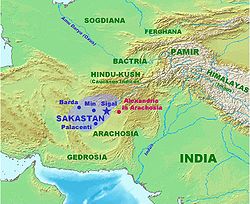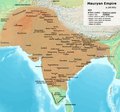File:Ashoka Maurya Empire.png

Original file (1,200 × 1,121 pixels, file size: 1.84 MB, MIME type: image/png)
Summary[edit]
Importing well cited and referenced Ashoka Empire Map by wikicommon user Indologist1 .License - public domain (cc-by-sa-3.0)
How , perfectly ,this user represented all important Provinces and Ashoka Stupas which was missing in most of the map I saw while wandering wikicommon.
Maximum extent of the Maurya Empire, as shown by :-
- The location of Ashoka's inscriptions, and visualized by ASI (Archeological Survey Of India) based on ancient inscriptions.
- Ancient Greecian , ancient Indian texts.[1]
- Modern archaeologist : Dougald J. W. O'Reilly.[2]
- Old archeologist : Myra Shackley:[3]
- Modern historian : Upinder Singh,[4]Jackson J. Spielvogel[5][6]Hugh Bowden.[7]
- Old historians:John Haywood;[8]Patrick Karl O'Brien,[9][10]H. C. Raychaudhuri,[11]John F. Cady,[12]Gerald Danzer,[13]Vincent Arthur Smith;[14] Robert Roswell Palmer,[15]Geoffrey Parker,[16]R. C. Majumdar.[17]
- Historical geographer:Joseph E. Schwartzberg.[18]
Brief Summary[edit]
Conquest of the Nanda Empire[edit]
Historically reliable inscription details of Chandragupta's campaign against Nanda Empire are unavailable and but later written Buddhist, Jain, and Hindu texts which claim Magadha was ruled by the Nanda dynasty, which, with Chanakya's counsel, Chandragupta conquered Nanda Empire.[19][20][21] The army of Chandragupta and Chanakya first conquered the Nanda outer territories, and finally besieged the Nanda capital Pataliputra. In contrast to the easy victory in Buddhist sources, the Hindu and Jain texts state that the campaign was bitterly fought because the Nanda dynasty had a powerful and well-trained army.[22][20]
Conquest of the Eastern Seleucid Empire[edit]
Megasthenes defined the region that Chandragupta won from Seleucus as likely western side Gedrosia which shares boundaries with the Euphrates River, and eastern side Arachosia shares boundaries with the Indus. The northern frontier boundary formed by Hindukush mountain range:
India, which is in shape quadrilateral, has its eastern as well as its 'western side bounded by the great sea, but on the northern side it is divided by Mount Hemôdos from that part of Skythia which is inhabited by those Skythians who are called the Sakai, while the fourth or western side is bounded by the river called the Indus.
- Book I Fragment I , Indica, Megasthanes [1]

Sandrokottos the king of the Indians, India forms the largest of the four parts into which Southorn Asia is divided, while the smallest part is that region which is included between the Euphrates and our own sea. The two remaining parts, which are separated from the others by the Euphrates and the Indus, and lie between these rivers... India is bounded on its eastern side, right onwards to the south, by the great ocean; that its northern frontier is formed by the Kaukasos range(Hindukush Range) as far as the junction of that range with Tauros; and that the boundary.
- Book I Fragment II , Indica, Megasthanes [2]
Greek historians mentioned the result of Seleucid–Mauryan war where Seleucid Empire's eastern satrapies( Gedrosia,Arachosia, Aria, and Paropamisadae) ceded to Mauryan Empire :
" Seleucus crossed the Indus and waged war with Sandrocottus [Maurya], king of he Indians, who dwelt on the banks of that stream, until they came to an understanding with each other and contracted a marriage relationship. Some of these exploits were performed before the death of Antigonus and some afterward."
" The geographical position of the tribes is as follows: along the Indus are the Paropamisadae, above whom lies the Paropamisus mountain: then, towards the south, the Arachoti: then next, towards the south, the Gedroseni, with the other tribes that occupy the seaboard; and the Indus lies, latitudinally, alongside all these places; and of these places, in part, some that lie along the Indus are held by Indians, although they formerly belonged to the Persians. Alexander [III 'the Great' of Macedon] took these away from the Arians and established settlements of his own, but Seleucus Nicator gave them to Sandrocottus [Chandragupta], upon terms of intermarriage and of receiving in exchange five hundred elephants. " — Strabo 15.2.9 [3]
Greecian historian Pliny also quoted a passage from Megasthanes work about Chandragupta Empire boundaries:
Most geographers, in fact, do not look upon India as bounded by the river Indus, but add to it the four satrapies of the Gedrose, the Arachotë, the Aria, and the Paropamisadë, the River Cophes thus forming the extreme boundary of India. According to other writers, however, all these territories, are reckoned as belonging to the country of the Aria.
Conquest of the Avanti[edit]
Ashoka served as a viceroy during the rule of his father Bindusara.According to established constitutional usage, Asoka as Prince served as viceroy in one of the remoter provinces of the Empire. This was the province of Western India called Avantirattham or province of Avanti with headquarter at Ujjain.[23]
Conquest of the Saurashtra[edit]
Chandragupta conquered Southern-Western part of India. Especially his conquest over Saurashtra and Sudarshana lake construction is preseved in later Satrapian king Rudradaman inscription:
(L.8) Transliteration: mauryasya rājyaḥ candra-guptasya rāṣṭriyena vaiśyena puṣpa-guptena kāritam śokasya mauryasya kṛte yavana-raj tuṣāra-saphenādhāyā
(L.8) for the sake of ordered to be made by the Vaishya Pushyagupta, the provincial governor of the Maurya king Chandragupta; adorned with conduits for Ashoka the Maurya by the Yavana king Tushaspha while governing; and by the conduit ordered to be made by him, constructed in a manner worthy of a king (and) seen in that breach.
—Junagadh rock inscription of Rudradaman[24]
Conquest of the Kalinga[edit]
Kalinga War plays a very important role in Mauryan history which changes a cruel Emperor Chanda-Ashoka to Priyadarshi Ashoka.
"Beloved-of-the-Gods, King Priyadarsi(Ashoka)conquered the Kalingas eight years after his coronation. One hundred and fifty thousand were deported, one hundred thousand were killed and many more died (from other causes). After the Kalingas had been conquered, Beloved-of-the-Gods came to feel a strong inclination towards the Dharma, a love for the Dharma and for instruction in Dharma. Now Beloved-of-the-Gods feels deep remorse for having conquered the Kalingas. "
— Ashoka, Major Rock Edict No. 13 [6]
Conquest of the Kuntala[edit]
Shikarpur Taluq, inscription 225 . Mentioned about Mauryan ruling in the region of Kuntala .The Kuntala country is an ancient Indian political region included the western Deccan and some parts of central,south Karnataka and north Mysore.
Kuntala-kshôpiyam pesarvett â-nava-Nanda-Gupta-kula-Mauryya-kshmâpar aldar llasaj-jasad [7]
-Shikarpur Taluq, inscription 225
Translation : The Kuntala country, which is like curls (kuntaja) to the lady Earth, was-ruled by the renowned nine Nandas, the Gupta and Mauryan kings. [8]
Licensing[edit]
| This work is licensed under the Creative Commons Attribution-ShareAlike 4.0 License. |
- ↑ Historical Quarterly, Vol-13, Issue no.-1-4 http://archive.org/details/dli.calcutta.06445%7Ctitle=Indian Historical Quarterly, Vol-13, Issue no.-1-4.
{{cite book}}: Check|url=value (help); Missing or empty|title=(help) - ↑ https://books.google.nl/books?id=eyHTschgg50C&pg=PA178&redir_esc=y#v=onepage&q&f=false
- ↑ Shackley, Myra L. (2006). Internet Archive. Amsterdam ; Boston : Elsevier. ISBN 978-0-7506-6348-9 of travel and tourism development http://archive.org/details/atlasoftraveltou0000shac%7Ctitle=Atlas of travel and tourism development.
{{cite book}}: Check|url=value (help); Missing or empty|title=(help) - ↑ https://archive.org/details/history-of-ancient-and-early-medeival-india-from-the-stone-age-to-the-12th-century-pdfdrive
- ↑ Spielvogel, Jackson J. (2012). Internet Archive. Boston, MA : Wadsworth Cengage Learning. ISBN 978-0-495-91329-0 civilization http://archive.org/details/westerncivilizat08edspie%7Ctitle=Western civilization.
{{cite book}}: Check|url=value (help); Missing or empty|title=(help) - ↑ https://books.google.nl/books?id=cCdmEAAAQBAJ&pg=PT143&redir_esc=y#v=onepage&q&f=false
- ↑ . Internet Archive. London : Times Books. 2002. ISBN 978-0-00-710859-6 Times ancient civilizations http://archive.org/details/timesancientcivi0000unse%7Ctitle=The Times ancient civilizations.
{{cite book}}: Check|url=value (help); Missing or empty|title=(help)CS1 maint: others (link) - ↑ Haywood, John (1997). Internet Archive. New York : Barnes & Noble Books. ISBN 978-0-7607-0687-9 of world history http://archive.org/details/atlasofworldhist00hayw%7Ctitle=Atlas of world history.
{{cite book}}: Check|url=value (help); Missing or empty|title=(help) - ↑ . Internet Archive. The Softback Preview. 1999. ISBN 978-0-540-07858-5 Atlas of World History: From the Origins of Humanity to the Year 2000 http://archive.org/details/philipsatlasofwo0000unse_u6t7%7Ctitle=Philip's Atlas of World History: From the Origins of Humanity to the Year 2000.
{{cite book}}: Check|url=value (help); Missing or empty|title=(help)CS1 maint: others (link) - ↑ https://books.google.nl/books?id=ffZy5tDjaUkC&pg=PA46&redir_esc=y#v=onepage&q&f=false
- ↑ https://www.routledge.com/India-The-Ancient-Past-A-History-of-the-Indian-Subcontinent-from-c-7000/Avari/p/book/9781138828216
- ↑ Cady, John F. (John Frank) (1964). Internet Archive. New York, McGraw-Hill Asia: its historical development http://archive.org/details/southeastasiaits0000cady_v1t8%7Ctitle=Southeast Asia: its historical development.
{{cite book}}: Check|url=value (help); Missing or empty|title=(help) - ↑ Danzer, Gerald A. (2000). Internet Archive. Ann Arbor, MI : Borders Press. ISBN 978-0-681-46572-5 atlas of world history http://archive.org/details/atlasofworldhist0000danz%7Ctitle=An atlas of world history.
{{cite book}}: Check|url=value (help); Missing or empty|title=(help) - ↑ Smith, Vincent Arthur, Press The Oxford History of India: From the Earliest Times to the End of 1911, pp. 104–106
{{citation}}: Check|url=value (help) - ↑ Rand McNally and Company; Palmer, R. R. (Robert Roswell) (1965). Internet Archive. Chicago McNally atlas of world history http://archive.org/details/randmcnallyatla00rand%7Ctitle=Rand McNally atlas of world history.
{{cite book}}: Check|url=value (help); Missing or empty|title=(help) - ↑ . Internet Archive. London : Times Books. 2008. ISBN 978-0-00-726731-6 Times compact history of the world http://archive.org/details/timescompacthist0000unse_g4l2%7Ctitle=The Times compact history of the world.
{{cite book}}: Check|url=value (help); Missing or empty|title=(help)CS1 maint: others (link) - ↑ Majumdar, R. C.; Raychaudhuri, H. C.; Datta, Kalikinkar, & Company An Advanced History of India, p. 104
{{citation}}: Check|url=value (help) - ↑ Schwartzberg, Joseph E. A Historical Atlas of South Asia , 2nd ed. (University of Minnesota, 1992), Plate III.B.4b (p.18) and Plate XIV.1a-c (p.145) |url=https://dsal.uchicago.edu/reference/schwartzberg/ |date=26 January 2021
- ↑ Thapar 2013, pp. 362–364.
- ↑ 20.0 20.1 Sen 1895, pp. 26–32.
- ↑ Upinder Singh 2008, p. 272.
- ↑ Mookerji 1988, pp. 28–33.
- ↑ Mookerji, Radhakumud (1962). Asoka. Motilal Banarsidass Publishe. ISBN 978-81-208-0582-8.
- ↑ "Junagadh Rock Inscription of Rudradaman", Project South Asia.Archived 23 February 2009 at the Wayback Machine
File history
Click on a date/time to view the file as it appeared at that time.
| Date/Time | Thumbnail | Dimensions | User | Comment | |
|---|---|---|---|---|---|
| current | 01:55, 2 December 2023 |  | 1,200 × 1,121 (1.84 MB) | Bharatwiki Socrates (talk | contribs) | Importing well cited and referenced Ashoka Empire Map by wikicommon user Indologist1 .License - public domain (cc-by-sa-3.0) https://commons.wikimedia.org/wiki/File:Ashoka_Maurya_Empire.png How , perfectly ,this user represented all important Provinces and Ashoka Stupas which was missing in most of the map I saw while wandering wikicommon. |
You cannot overwrite this file.
File usage
The following 4 pages use this file: